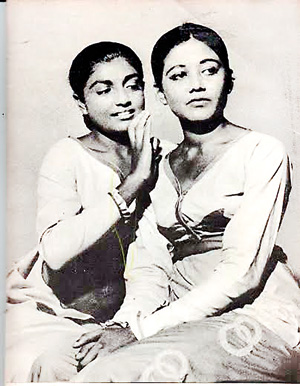The unforgettable ‘Mother Courage’ – Kala Korner by Dee Cee
View(s):From ‘Rattaran’ in 1958 to ‘Vikurthi’ in 1982, she gave her best in both acting and then production. It was superb entertainment for the then youngish (now ‘oldies’) regular theatregoers like us. And then she switched on to children’s theatre giving ample enjoyment to both children and adults. For several decades Somalatha Subasinghe was a household name among theatre lovers. We ‘Peradenians’ of the Gunasena Galappatti era had something special to look forward when she performed: possibly because we were all admirers of Dr. Sarachchandra and his ‘golayas’.

Somalatha (right) as Sara in ‘Mudu Puthu’
It’s not easy to forget her as the old lady in Sarachchandra’s ‘Rattaran’, Sara in Galappatti’s ‘Mudu Puttu’ or Mother Courage in Henry Jayasena’s ‘Diriya Mawa’. That was on stage. And in the big screen, her roles in Lester James Peries’ ‘Madol Duwa’, Sunil Ariyaratne’s ‘Siribo Aiya’ and Tissa Abeysekera’s ‘Maha Gedera’ and ‘Viragaya’ remain etched in my memory.
We were simply enthralled when she appeared on stage or screen. She was a disciplined player. She confessed that she owed a lot to her ‘guru’ Dr. Sarachchandra. Reminiscing about the early days she wrote: “He selected me to play the old woman in ‘Rattaran’. I remember the way he trained me to walk like the old woman. He selected the movements for that character from the styles used in traditional ‘kolam’. When the old one gets lost in the jungle and started hovering around not knowing where to go, he used the ‘nonchikolama’. I didn’t have a clue about them at that time. I had been educated in an environment with emphasis on English. But under his guidance we learnt to appreciate our heritage and realised they are linked to our creative work and folk culture.”
Sarachchandra got her involved in his theatre productions which she found to be of much benefit when she started producing plays. In ‘Vella Vehum’, the play he produced with a cast selected from among the minor employees at Peradeniya, Somalatha was given several tasks behind the stage including assisting Dr. Siri Gunasinghe in designing costumes and stage decor. She gained quite a lot of experience by being in the stage management team in several plays of Sarachchandra’s including ‘Elova Gihin Melova Ava’, ‘Ekata Mata Hina Hina’ and ‘Vessantara’.
Although she was keen to learn dancing after leaving the university, following Sarachchandra’s advice that she should not neglect her acting, she dropped the idea. That’s how she acted in his ‘Pabavati’, Galappatti’s ‘Mudu Puttu’ and Dayananda Gunawardena’s ‘Nari Bena’.
Somalatha had a busy schedule as an actress. Drama producers were behind her during the golden era of Sinhala theatre in the 1960s and 70s. Glancing through the list of plays she had taken part in it’s pretty impressive. Apart from ‘Mudu Puttu’, she was in Galappatti’s ‘Liya Thambara’ too. Other producers who picked her were Sidat Sri Nandalochana (‘Attaka Mal Parava Giya’), Dhamma Jagoda (‘Ves Muhunu’), Ranjith Dharmakeerthi (‘Hiru Nethi Lowa’, ‘Cerry Uyana’, ‘Anagara Ganga Gala Basee’), Chula Kariyawasam (Sirith Virith’) and Ranjani Obeysekera (‘Bernadage Sipiri Geya’).
Though she acted in a number of films, she is remembered more for her presence on stage. Somalatha started the Lanka Children’s and Youth Theatre Foundation (LCYTF) in the early 1980s and directed ‘Vikurti’, the stage play which became a sensation. The contemporary theme she selected discussed the plight of the youth who struggle to pass the GCE O’ Level and A’Level (‘ehe beluvath vibhage, mehe beluvath vibhage’ becoming an instant hit) and the never ending ‘tuition mania’. The theme being so close to everyone’s heart and being a sleek production with classy acting, the play is running to this day – for over 30 years.
She translated a number of well-known foreign dramas and produced them. “I produce plays not just for entertainment. It’s when I feel an acute sorrow in my heart about what’s going on in society, I get inspired” she summed up her mission. Her service to children’s theatre will be long remembered. ‘Punchi Apata Den Thwerei’, ‘Toppi Velenda’, ‘Rathmali’, ‘Gamarala Divya Loketa’, ‘Hima Kumariya’, ‘Valas Pavula’, ‘Para Haraha’ are among the most popular ones. The Foundation has delivered and remains the topmost institution for children’s and youth theatre productions.
Many have found participation in the Foundation’s seminars and workshops most useful. What Vajira and daughter Upekha achieved by way of providing an avenue for children with talent in dancing to progress, Somalatha and daughter Kaushalya have done in the field of acting. Somalatha is no more. We feel sad about it. But she has left behind a legacy which will benefit the coming generations.


